In the Footsteps of Francis Martin Drexel: A Field Trip to Dornbirn, Austria
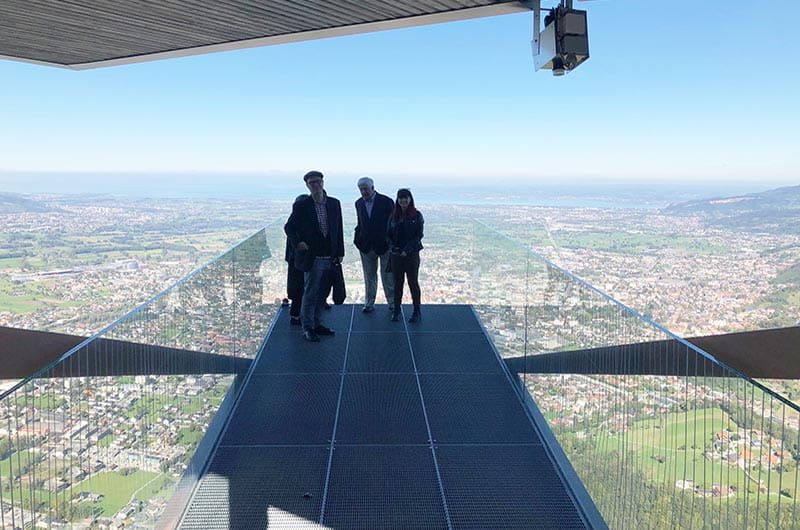
Editor’s note: Earlier this term, a team of 10 Drexel University professors, students and alumni flew to Austria to visit the ancestral birthplace of the University founder’s father. Anthony J. Drexel, the founder of the then-Drexel Institute of Art, Science and Industry, built the family banking business that was started by his father Francis Martin Drexel, who left his native Austria to make his fortune in America.
The once-in-a-lifetime adventure is recounted below by two College of Arts and Sciences professors who made the journey: Scott Knowles, PhD, professor and department head of the Department of History, and Eric Zillmer, PsyD, professor in the Department of Psychology and Director of Athletics.
In early October 2018, Drexel University History Professor Scott Knowles and Psychology Professor Eric Zillmer accompanied a group of three history majors and five alumni and friends of the University on a five-day journey to Dornbirn, Austria. Francis Martin Drexel (FMD) was born in there in 1792 and left on May 12, 1817, to set sail from Amsterdam on the ship John of Baltimore to Philadelphia. He arrived 72 days later and changed the history of international banking as well as set the course for our own University. FMD died in Philadelphia in a tragic railway accident in 1863.
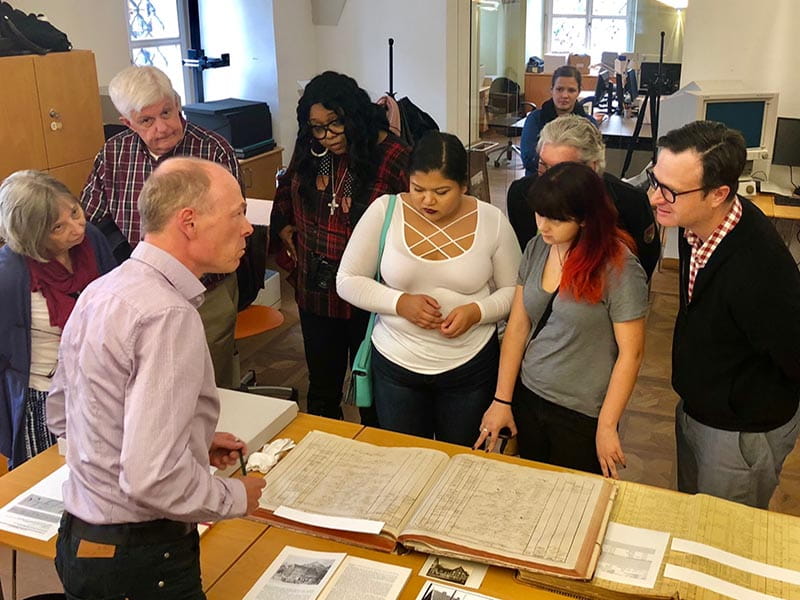
Anthony J. Drexel (AJ), his son, was thus a first-generation Austrian-American, with interests in European art, architecture and innovations in higher education that connect the University’s history back to the Francis Martin Drexel story.
Because FMD’s life was so extraordinary, it seems fitting that we give prominence to his upbringing in Dornbirn, Austria. And, with any fairy-tale story, there are mysteries. FMD’s life and departure in Dornbirn are still largely undocumented. With this mystery in mind, our group travelled to Austria not only to celebrate the legacy of the Drexel family name and to sample the rich cuisine of Austria’s Vorarlberg region, but also to engage in some serious archival work on FMD.
Wiener Schnitzel und Kartoffel
What hits you first in Dornbirn is the exceptional culture of food, which is both culinary and social. Upon landing in Zurich and after a short one-hour trip east, we first “ate our way” through a bakery in the pedestrian zone of Dornbirn. Each subsequent meal became a celebration of food and conversation. Favorites among our students were fladl suppe (German pancake soup), wiener schnitzel (pan-fried veal cutlet), käsespätzle (egg noodles in cheese), kaiserschmarrn (shredded pancakes) and, of course, apfelstrudel (apple strudel). We ate on top of a mountain, in fancy restaurants, from street vendors and in rustic places. The food was always exceptional. In Austria, they have a saying that true love “goes through the stomach,” and we can see why. Most importantly, our meals served as a catalyst for our inquiry into FMD; a sort of “history jam” over food. Fun!

The Dornbirn Archives
To investigate the mystery of why FMD left Dornbirn and what his family history can teach us, we set out to visit the Dornbirn Archives, a beautiful building that sits in the center of town on a lively square and which also houses the local museum. Our friends from the city office of Dornbirn assembled a crack team of historians who were under the direction of chief archivist Werner Matt.
When Drexel lived in Dornbirn, he was part of a family that was privileged and had established itself in the region since the 15th century. His father was a respected businessman and a pioneer in local industrialization, with contacts to Italy and Switzerland. Francis Martin was educated in Italy and had the “Original Drexel Education” — a cross-disciplinary education in arts and business, as well as practical and applied under his father’s guidance. His life was marked by early turmoil, when he, under the cloak of night and fog, crossed the nearby Rhine River to escape enlistment into Napoleon’s army, only to return to Dornbirn years later to plan his trip to Philadelphia.
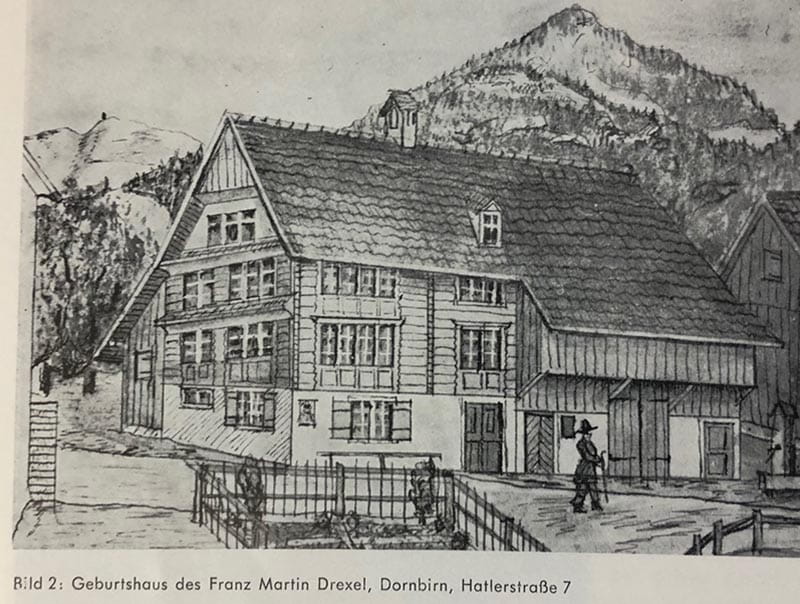
FMD must have had considerable confidence in his skills to set out to America to establish himself as a painter. He was multilingual and must have had a keen sense of international politics. He would later, together with his son AJ, change the world of transatlantic investment banking, in the process becoming Austria’s most famous immigrant to the U.S.
The first document we examined was a city record that was transcribed in approximately 1900 from even older records. It documented the population of Dornbirn, including the family of FMD’s father, Franz Josef Drexel, his wife and their five children. It was with a degree of sadness that we saw that two of FMD’s siblings had died before the age of 10. Examining other family records of the time shows that the loss of a child seemed to be a common statistic. Clearly written on the document was an entry that tells us FMD had left Dornbirn for “Philadelfia.”
Next we examined two documents we have never seen before. Namely, two tax records that showed the wealth of the Drexel family 20 years apart. The first one ca. 1790 indicated that the Drexel family had many holdings in Dornbirn including numerous properties and a very large house.
What we can say is that the Drexel family had international business connections and that FMD was born into wealth. It also explains why FMD was educated in Italy and Switzerland, and spoke five languages. He would later in his life become a prolific writer of his global journeys, always written in almost perfect English. We could not help but point out that FMD, in fact, was educated similarly to our current University students who were examining his records: globally, multidisciplinary and with applied intent.
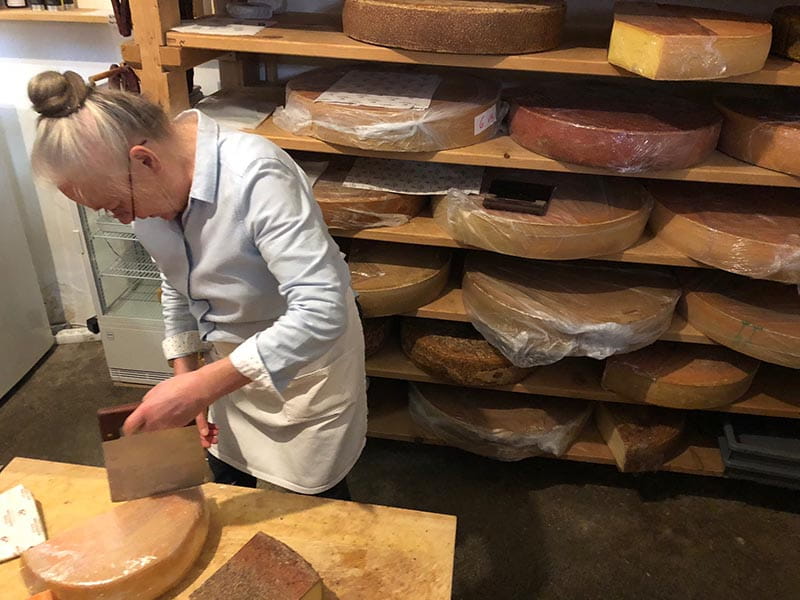
The second document written in ca. 1808 showed that the Drexels had moved out of the large farmhouse FMD was born in and there were significant fewer assets listed. This immediately suggested to us that the Drexel family had endured some financial hardships, after all the Napoleon wars had swept through Europe including Dornbirn. Did FMD leave for Philadelphia to find richer pastures?
This possibility was heavily discussed among the students and alumni that evening over schnitzel and chips. We could not wait for the next day to dig deeper into the Archives, which the city of Dornbirn had so graciously made available to us. But the next day was a “disappointment.” Additional archival research suggested that the second tax records were actually recorded by the Bavarians, who were governing the land at that time, using a different format of record keeping. In other words, we were comparing apples to oranges. Of course this was a great example for our Drexel students that not all hypotheses in history turn out to be true. We will have to return to Dornbirn to look further into the matter. For the moment, it is not clear if the adventurous FMD, full of wanderlust, felt a calling to reach Philadelphia or if he was “pushed” out of Dornbirn.
University of Applied Sciences Vorarlberg
The next day we visited an international business class and specifically the “Start-Up Stube” incubator at the University of Applied Sciences Vorarlberg. We were introduced to the University’s “World Café” and discussed collaboratively why cultural diversity is important in the workplace. The co-founder of the University’s entrepreneur program, Magdalena Meusberger, PhD, was our facilitator. We felt at home on the university’s campus and it was very interesting to discuss with the Austrian students about why sexual harassment in the U.S. workplace is an essential safety issue. Even though the students were predominantly from the region, they articulated many of the same concerns our Drexel students had about the topic. We left the discussion energized and with the knowledge that students on both sides of the Atlantic are more alike than they are different.
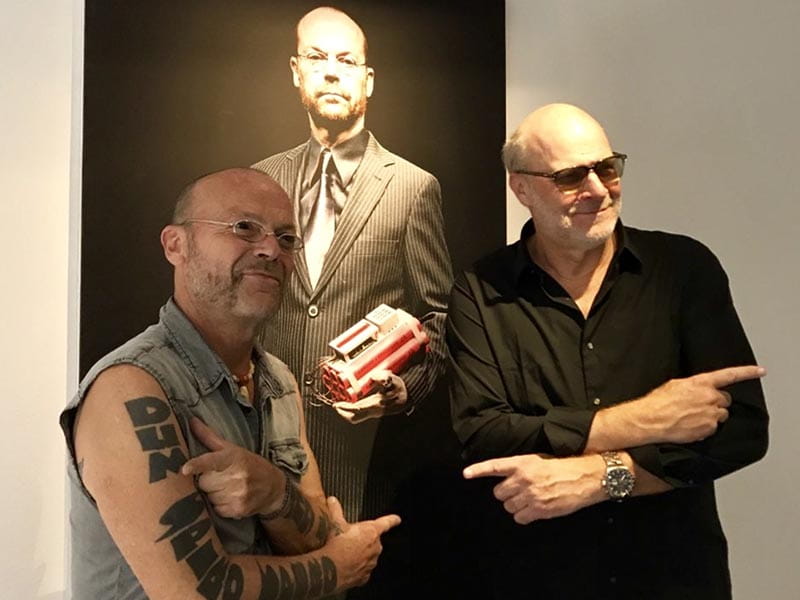
The City of Dornbirn
The partnership with the city of Dornbirn had been established in 2009, the year we confirmed the University’s connection to the region. Since then, there has been a great friendship between our University and the city. The city office arranged for us to use their cable car up the mountain Karren, a tour of the Jewish quarters and museum in Hohnemens, a trip to the Bregenz Modern art museum, a visit to the opening of a temporary photo exhibit of Frida Kahlo, a city tour to nearby medieval Feldkirch, and access to the night of the museums, where all museums in the region were open to 1 am and featured the awesome combination of music entertainment and history. The highlight however, was a group dinner with city officials in the 500-year old Rote Haus.
Summary
Dornbirn is a charming city of 50,000 nestled in the foothill of the Alps in the Vorarlberg region, and it is located about an easy one-hour car ride east of Zurich, Switzerland. The largest and busiest city in Vorarlberg and the tenth largest in all of Austria, Dornbirn is an important commercial and shopping center. It is a modern, yet quaint place, full of life and steeped rich in history
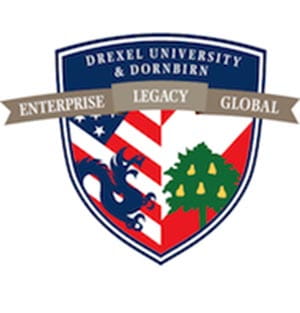
The trip visiting the symbolic home of Drexel University reinforced our great pride for our founder and his family. When Francis Martin Drexel left Dornbirn, he anticipated he would return within a year, but of course he spent the rest of his life in Philadelphia. It is ironic that over 200 years later, a group of students, alumni and professors traveled to Dornbirn completing his “round-trip.” The family legacy is more far reaching than could have been predicted some 200 years ago. We left knowing that Dornbirn is a very special place and will always have a connection to modern-day Drexel University.
This is first time we took students to test whether we can design an applied history class around the trip. Verdict is in: we think it can reenergize our history major and is an excellent way to learn about not only history, but cultural relativity and metacognition.
Written by: Scott Knowles, PhD, professor and department head of the Department of History in the College of Arts and Sciences, and Eric Zillmer, PsyD, professor in the Department of Psychology in the College of Arts and Sciences and Director of Athletics.
In This Article
Drexel News is produced by
University Marketing and Communications.
